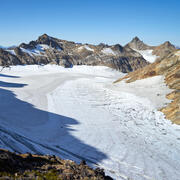Cryosphere: Earth’s Snow, Ice, and Permafrost
The Arctic and frozen lands are experiencing rapid changes and play large roles in infrastructure, natural resources, and regulation of global climate. The Climate R&D Program conducts research to improve our understanding of avalanches, permafrost, glaciers, and sea ice, and their response to changing climates in the past, present, and future.












